88% of small businesses supply chains will use suppliers closer to home by next year.
Supply chain managers at a small business need to be focused on driving operations and keeping things running smoothly. This leaves you little time for market research and macro trend analysis that would help inform your supply chain management strategy. Thankfully, we’re here to help.
This report is focused on small businesses and will share the top trends that are shaping the future of supply chain management (SCM), as well as provide analyst’s tips and insight on the macro factors driving these changes.
We surveyed* 300 supply chain professionals at small to midsize businesses (with 1,000 or fewer employees and an annual revenue of $500 million or less) to learn about the challenges and solutions for navigating the changing industry. Based on the results, we’ve identified five trends you need to know about.
/ Key highlights
Nearshoring is happening fast: 88% of small and midsize supply chain professionals have plans to switch at least some of their suppliers to ones closer to the U.S. 45% plan to switch all of them.
The economy is top concern: 65% of SCM professionals say economic inflation is a top concern going into 2023. Lack of inventory (43%) and economic recession (42%) follow.
Tech investments are up: 90% report plans to increase or maintain their investment in emerging technologies. Software-based emerging tech, such as IoT and AI, are on the rise while hardware-based ones lag in adoption.
Seasonal forecasting reduces excess inventory concerns: 67% say their forecasting techniques have been successful the past 6 months leading to only 14% reporting excess inventory as a top concern going into 2023.
Cooperative procurement on the rise: 64% of SMB supply chains have joined or plan to join a group purchasing org (GPO) to help manage procurement costs and challenges.
Now let’s take a look at each of these trends and provide insight on why these are the macro trends that will continue to impact the future of your supply chain.
Small business supply chains are moving most or all suppliers closer to the U.S. faster than predicted
Many corporate giants have already found new suppliers closer to home and have made substantial investments in U.S. manufacturing. Apple has nearly doubled the number of their suppliers based in the U.S. just this year[1]. General Motors[2][3] and Boeing[4] are each investing heavily in manufacturing plants in the U.S. and Mexico[5]. But the switch to nearshoringMost industry professionals predicted this change would happen very slowly, over five or more years. But even the 2022 numbers we see in the data were stronger than those predictions, and 2023 will continue to see a rapid shift to nearby suppliers.
Here’s a comparison of where SMBs’ suppliers were located in 2022 versus the plans for supplier locations in 2023.
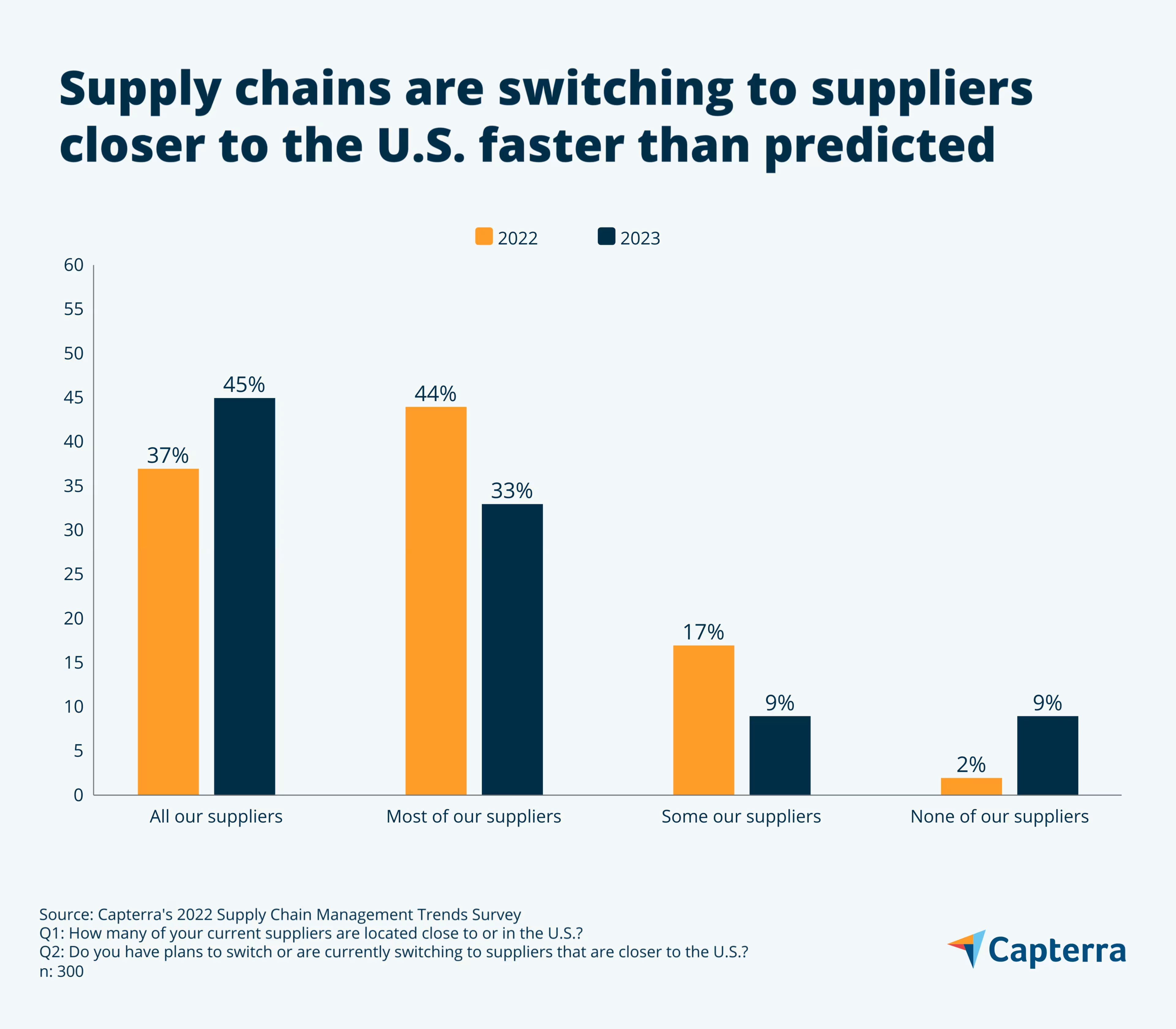
As our North American neighbors are boasting costs at or near those charged overseas, the time couldn’t be better to be switching to nearby suppliers. Here’s an overview of the benefits that you can expect to see with the switch:
Easier to manage critical situations. The shorter distance to travel and smaller time-zone differences reduces the cost and effort required to visit your suppliers when needed.
Financial incentives. Mexico, Canada, and the Central American region known as The Northern Triangle are each working hard to attract U.S. businesses to establish supplier relationships. They offer competitive labor costs and quicker delivery, making them strong contenders to replace overseas manufacturing.
Strong existing trade agreements. The U.S. currently has several open trade agreements with nearby countries and over a dozen other agreements with countries that aren’t quite as nearby, including Australia. This makes navigating the paperwork and import requirements much easier.
More resilient transportation routes. The transportation infrastructure across North America allows for less complex transportation of goods, opposed to shipping ports and the perils of sea travel. And as the climate continues to affect transportation, the closer to your customers your product can be throughout the supply chain the better.
Fewer cultural disparities. Many suppliers in nearby countries have similar labor, health, and safety laws as the U.S. A majority of customers have strong opinions on these topics and highly value an ethical supply chain. This also makes it easier to resolve issues together if they arise.
/ Analyst’s tip
Macro factors, such as war and climate change, will continue to change the supply chain landscape. But as more and more manufacturing plants open in North and South America, it’s a safe bet to move your supply chain network closer to home sooner rather than later. Map out your current supply chain as far up the chain as possible and then research potential replacement suppliers that are closer to home.
The strained economy and low inventory are top stressors
Economic inflation is by far the biggest concern of SCM professionals with 65% placing it in their top three going into 2023.
A global economy suffering inflation and recession is a double-edged sword. It means consumers are spending less money buying your product, and your costs, from inventory prices to logistics costs, increase. SMBs are hit harder than larger companies who have more resources available to them to absorb higher procurement and logistics costs and to reduce operating costs, such as labor.
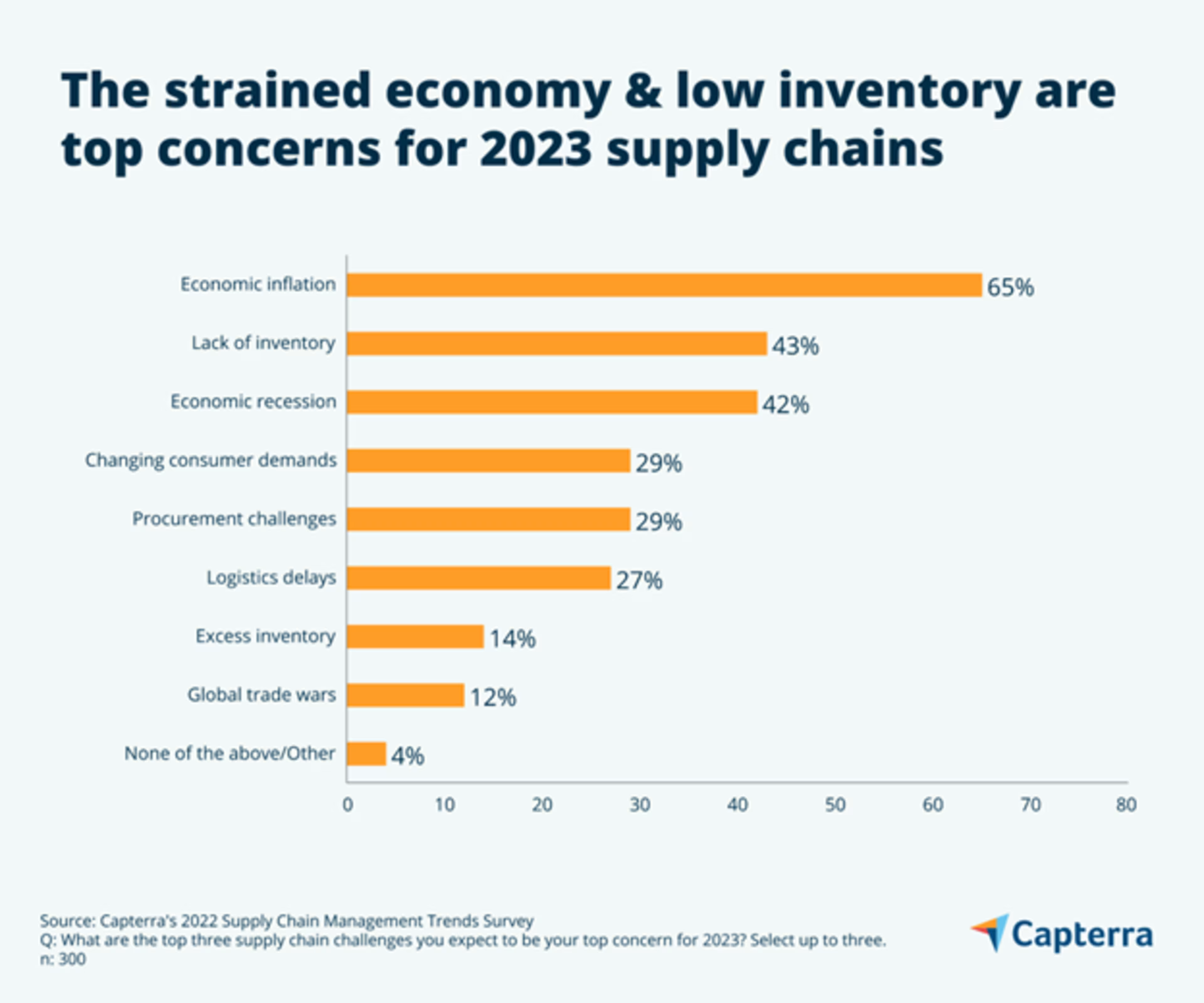
The root causes for the lack of inventory will continue through 2023 for most supply chains. They also are key drivers in the economic inflation most of the world is experiencing. They include:
Intermittent lockdowns and closing of manufacturing in China in response to the COVID-19 pandemic.
The transition period as U.S. businesses continue to find new suppliers closer to home.
Ongoing shortage of raw materials due to climate change and many supplier countries continue to prioritize non-western trade partnerships.
Logistics snarls due to climate change. These include major waterways having to close due to low water levels and excessive flooding or fires making transportation impossible.
/ Analyst’s tip
Luckily, this time for change to the status quo of supply chain practices means you can develop a new strategy to help navigate and succeed in the future. Focus on cost optimization to help your business survive these tough economic times. One way is to work with your suppliers and partners to negotiate your contract for better rates.
Software-based emerging tech is on the rise while hardware-based ones lag behind
Ninety percent of SMB supply chain professionals report plans to increase or maintain their investment in emerging tech. Overall, small business supply chains are investing in software-based emerging tech at twice the rate of hardware-based ones.
We’re seeing this trend at large enterprises as well. While HR and diversity and inclusion teams are being hit the hardest with this year’s layoffs, Amazon[6] and other major corporations are eliminating or greatly reducing their robotics teams.
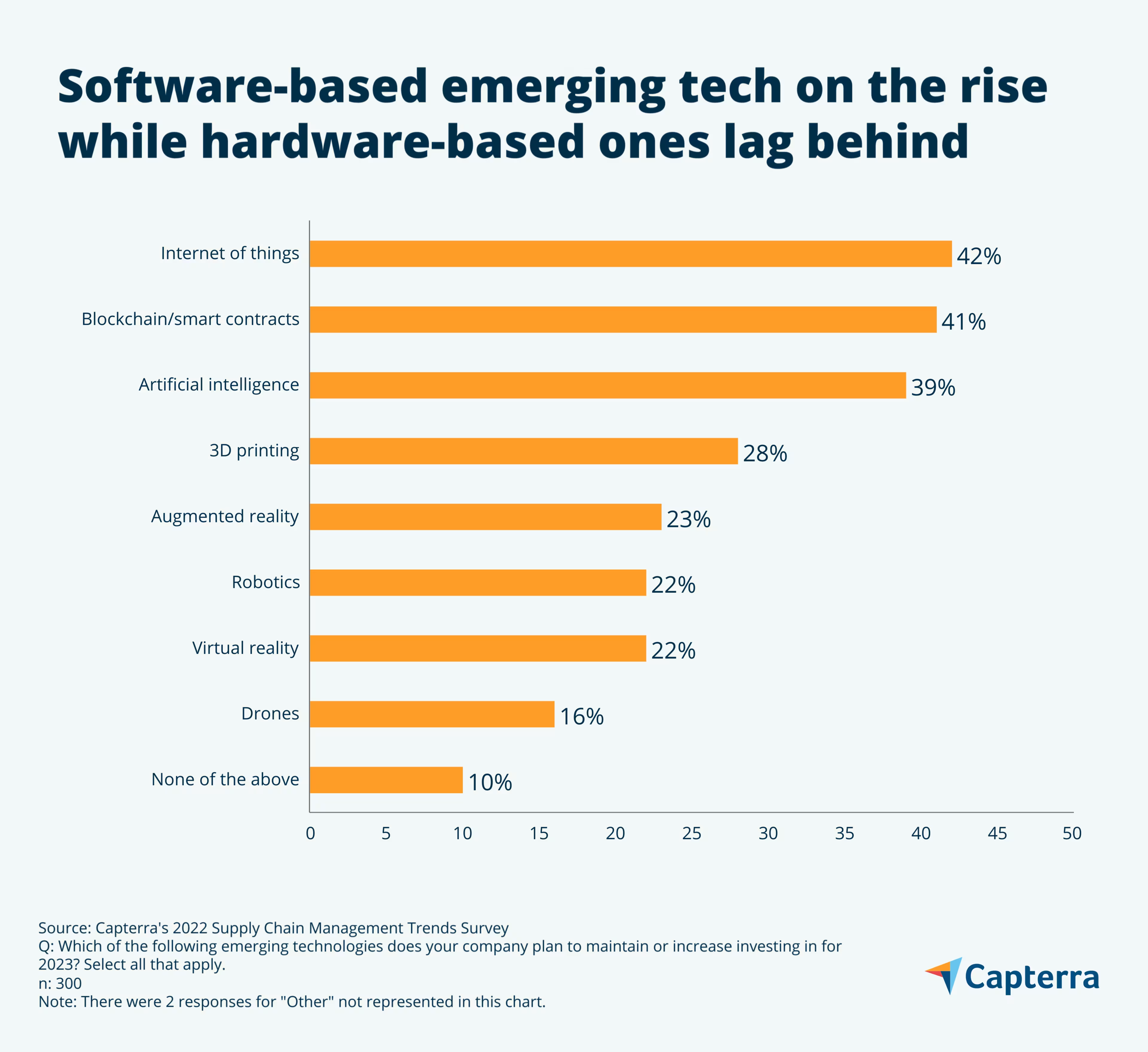
Let’s take a look at the top three emerging technologies supply chain professionals are investing in and their benefits.
What is IoT for supply chains?
The internet of things (IoT) is the digital enhancement of physical items, such as shipping containers and trucks, that connects the device to your computer systems via data or Wi-Fi networks. Essentially, it gives physical things an internet connection. IoT allows you to monitor, report on, and sometimes even exchange data with the device.
The benefits of IoT devices include:
Tracking the speed of transportation to know when shipments will arrive.
Monitoring the storage conditions, such as temperature and humidity levels.
Performing administrative tasks upon receipt of goods without having to be physically present.
What is blockchain for supply chains?
In layman’s terms, a blockchain network is an online ledger where authorized persons in the supply chain process add information. Each person in your supply network can log in to the blockchain system and log events, data, or transactions, creating their “block” that is then attached to the “chain” (the ledger).
The benefits of blockchain include:
Promoting honest transparency as everyone is using the shared ledger as the single source of truth.
Reducing the amount of time required to track down updates with your partners.
Creating smart contacts which are autonomous and cost effective legally-binding agreements between parties. Smart contracts do not require brokers to oversee the agreement, which eliminates the risk of manipulation by third parties.
What is artificial intelligence for supply chains?
Artificial intelligence (AI) is software programming that aims to mimic some types of human intelligence, such as perceiving, synthesizing, and inferring information. For example, you can problem solve with AI via simulations and analysis of historical data and outcomes. You can purchase software systems that have AI-enabled features, such as resource planning and inventory forecasting.
The benefits of AI include:
Running data analysis 24/7 without interruption and with little-to-no downtime.
Monitoring your IoT devices and generating reports to help optimize storage use, logistics timing, and more.
Negotiating shipping and procurement rates faster and more often than a human can.
/ Analyst’s tip
Nearly 30% of SMBs plan to implement a new supply chain management tool in 2023. When looking at new tools, the advanced features, such as forecasting enhanced with artificial intelligence and compatibility with IoT devices, will be critical. Talk with the vendor you’re with now to see if your current software has these capabilities. And if not, it could be time to consider a newer system.
67% of SMB supply chains say their forecasting techniques were helpful in preventing excess inventory
Major retailers have been stuck with excess inventory this year, and we see weekly news reports about Walmart and Target scrambling to offload it[7]. But small businesses seemed to have fared a bit better this year with only 14% of respondents saying excess inventory is a top concern. The cause for this could be found in the forecasting techniques they used.
Here’s a look at the forecasting demand methods SMB supply chain professionals used in 2022 and plan to use in 2023 to see such success.
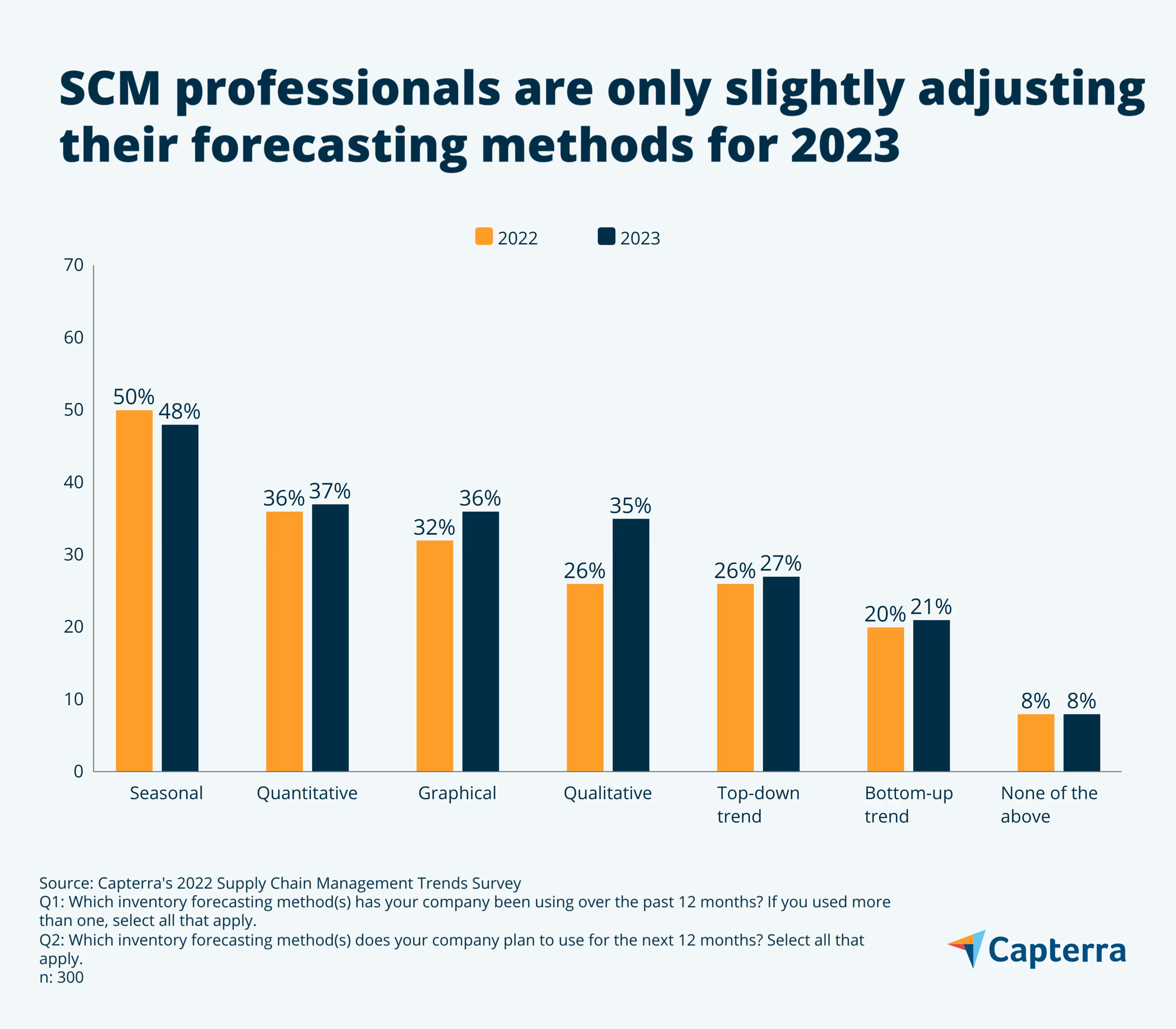
Seasonal and quantitative forecasting are top methods used and the majority of businesses (67%) say they were successful strategies. Let’s take a look at each of these techniques.
What is seasonal demand forecasting?
Seasonal demand forecasting is a method based on the historical demand for products as driven by specific times of the year. For example, in retail, August and September are back-to-school season and require specific changes to the types, levels, and timing of a retailer’s inventory.
What is quantitative forecasting?
Quantitative forecasting is a technique that uses historical data, statistical calculations, and sales projections to determine future demand. As inventory management software advances, it can perform more complex calculations with more data points than has ever been possible before. This enables SCM managers to make more accurate forecasts, and therefore reduce the risk of mismatched inventory.
Accurate demand forecasting is one thing, but actually getting the inventory you need at the time you need it is another story. Let’s now take a look at the popular solution many small businesses are trying out to alleviate their procurement challenges.
A majority of SMB supply chains have joined or plan to join a GPO to help manage procurement costs and challenges
Sixty-one percent of respondents report experiencing moderate to significant procurement challenges in the past six months**. To help address the issues small businesses face when buying products, many are turning toward a collaborative approach. Either by working directly with each other to place larger orders or with their supplier who then has greater purchasing power, SMBs are embracing group purchasing organizations (GPO) at higher rates than ever before.
The number of SMBs in a GPO has more than doubled in just the last year. Here’s the breakdown:
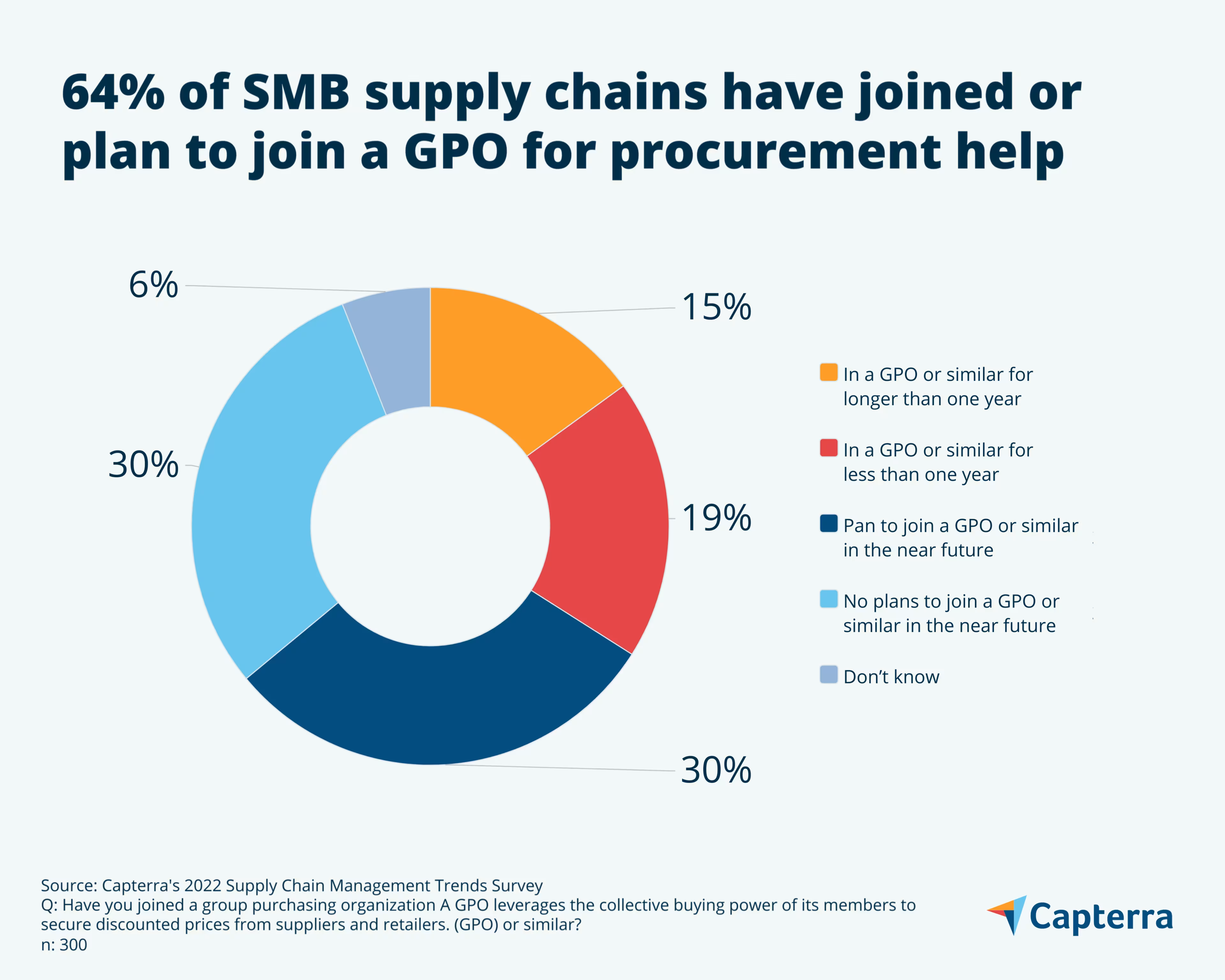
Some industries, such as medical, have embraced this approach steadily over the past decade, while more competitive markets, such as clothing and electronics, previously kept their networks to themselves. This “every man for himself” thinking hasn’t proven beneficial to small businesses or consumers, especially in the wake of the logistics behemoth, Amazon.
/ Analyst’s tip
We’re still in the early stages of this cooperative approach, but there are plans in motion for other aspects of supply chain management to also go this route, including warehousing and distribution. We recommend strongly considering this approach for your long-term supply chain strategy.
Who to watch
The concept of collective bargaining isn’t new but the willingness to open up and share suppliers with potential competitors is. In fact, this approach has investment and innovation from some of today’s biggest retailers. Specifically, Shekar Natarajan, American Eagle’s chief supply chain officer, is leading the way by creating a networking platform where businesses can join to gain access to more suppliers and pool resources in order to gain better deals. This is one variation of a GPO.
Report recap
The supply chain management techniques that dominated the last 30 years are no longer supporting consumer behavior and logistics and manufacturing capabilities. Decades of globalization have created an intricate web of the trade of goods. But recent, major events have caused possibly irreparable damage. From the COVID-19 pandemic to the disastrous effects of climate change to the global social connectivity that has shed light on the human rights violations happening in the countries where we’ve established this intricate web, global supply chains require changes.
Throughout this report, we shared the trends that will shape small businesses’ supply chain strategies through 2023 and beyond. We hope these insights will help you develop an effective supply chain management strategy for your small business.
Here’s a recap of the analyst tips we shared throughout:
Don’t wait to nearshore where possible. Map out your current supply chain as far up the chain as possible and then research potential replacement suppliers that are closer to home.
Focus on cost optimization with approaches such as working with your suppliers and partners to negotiate your contract for better rates.
Evaluate the advanced features of your current SCM system, such as AI-enhanced forecasting and support for IoT devices. If you don’t have them now, it could be time to consider a newer system.
Take a cooperative approach to your procurement, warehousing, and logistics strategies, especially for the long term.
Survey demographics
For this report, we surveyed only small and midsize businesses to bring you focused insights for your small business. Below you will find the demographics of the survey respondents so you can see the size and types of businesses, from annual revenue to industry.
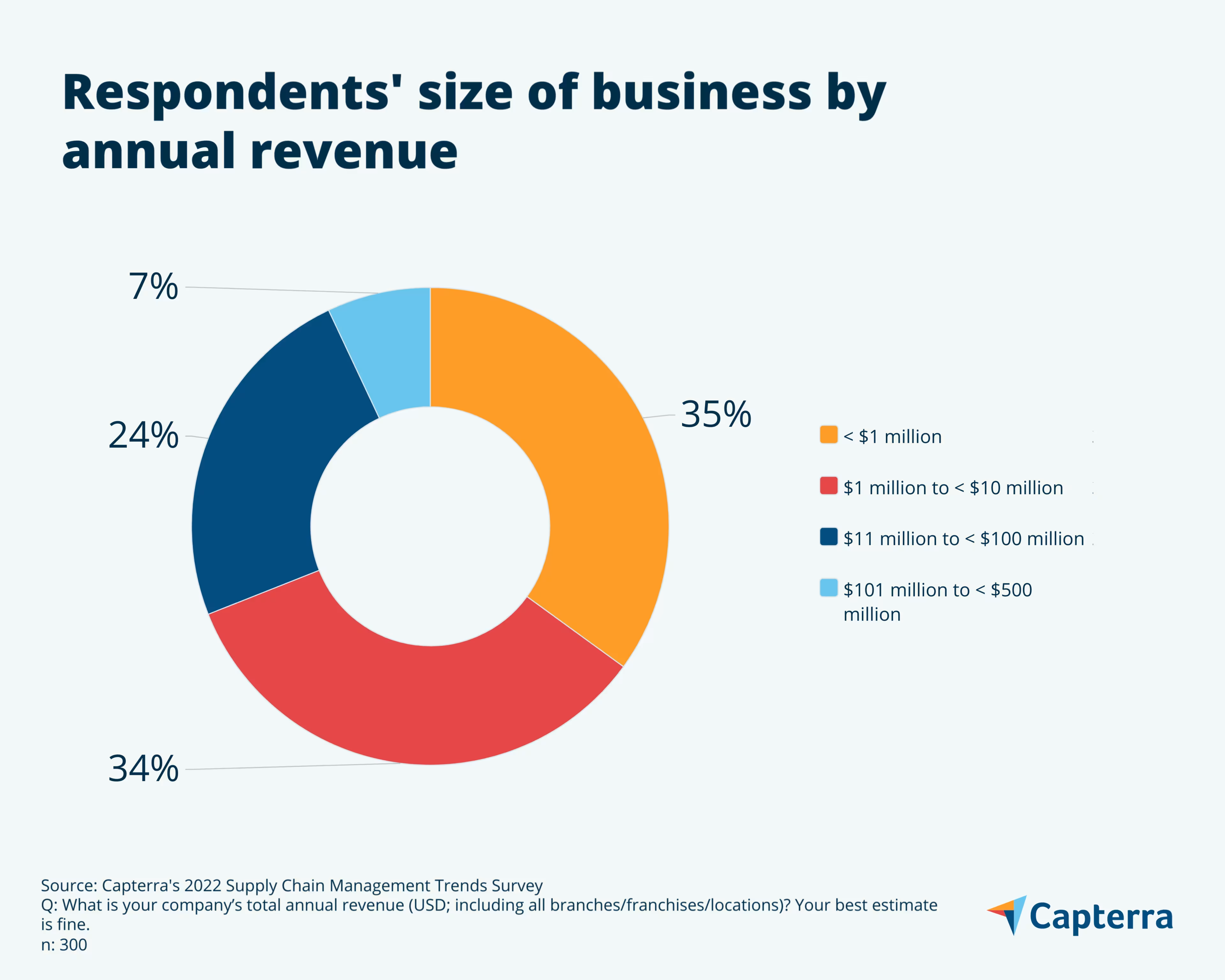
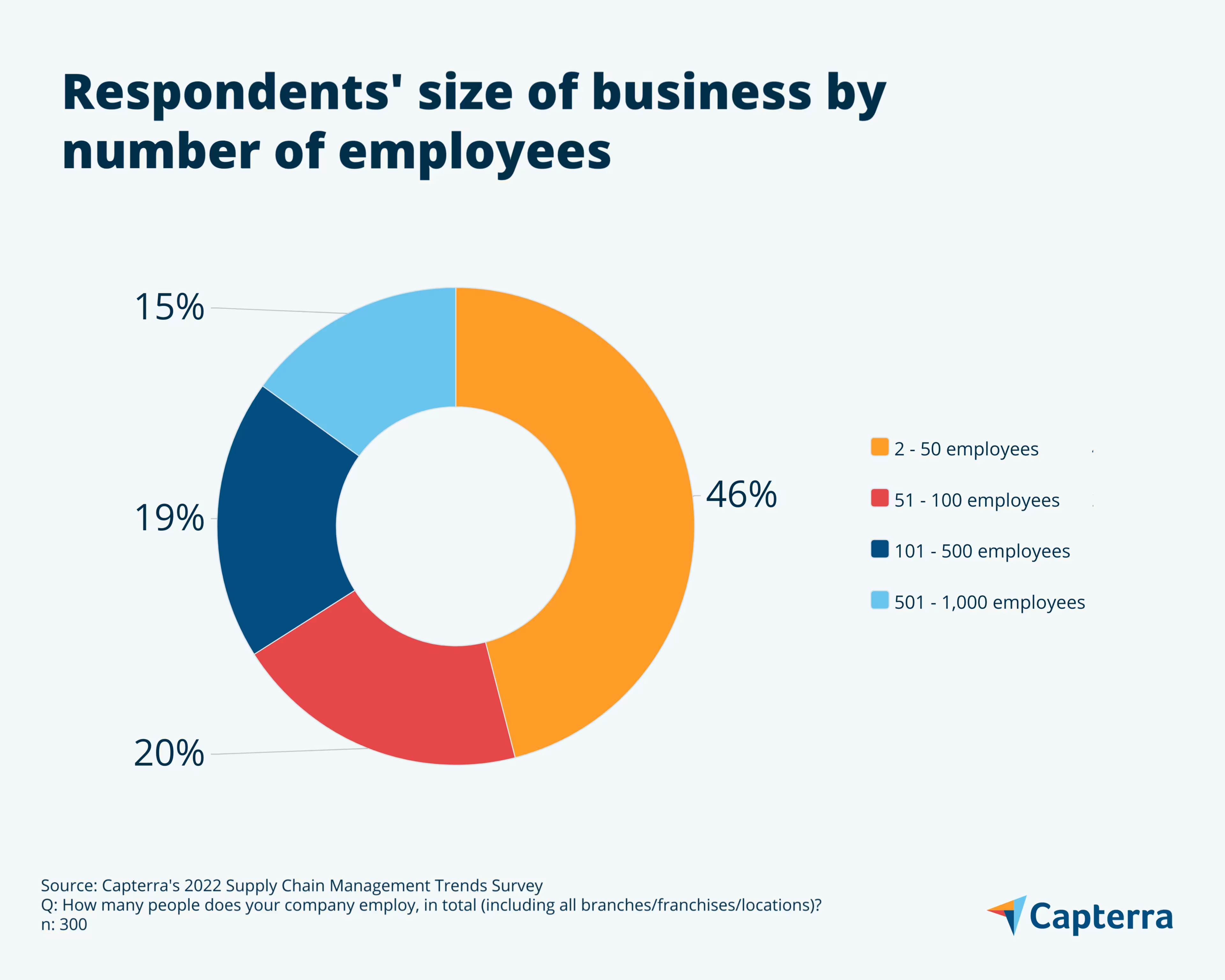
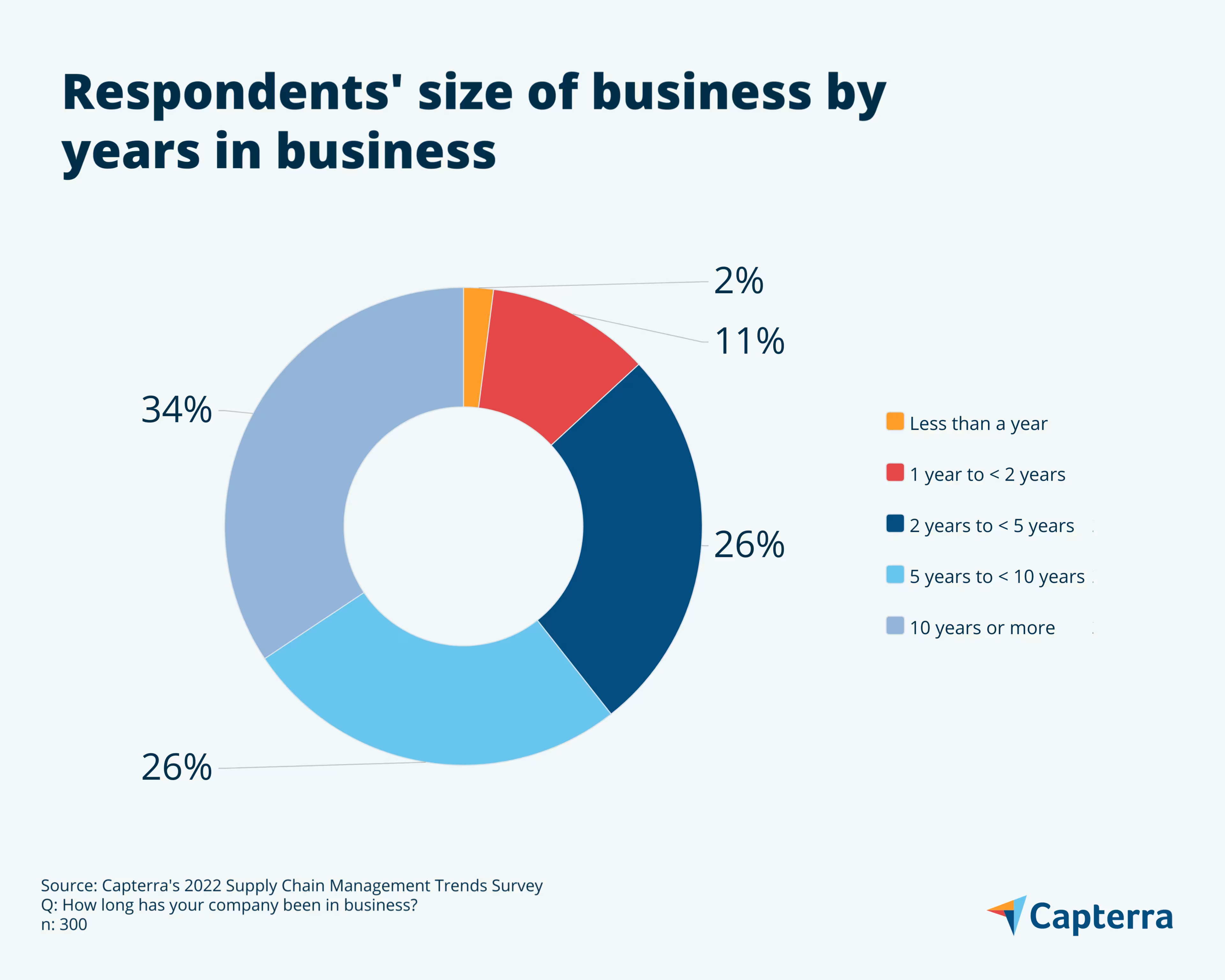
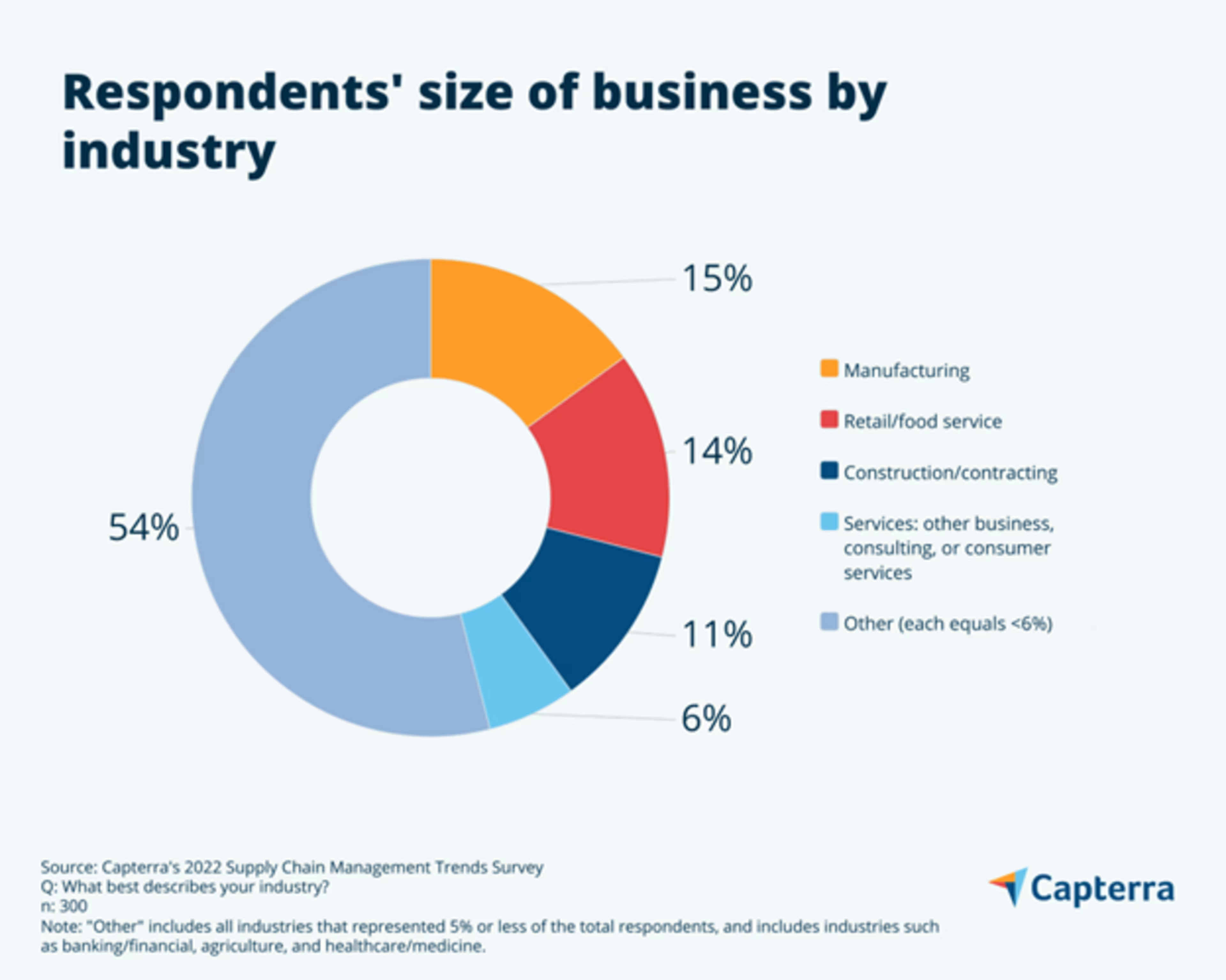
Note: All numbers have been rounded to the nearest whole number, therefore some charts may not add up to 100.
